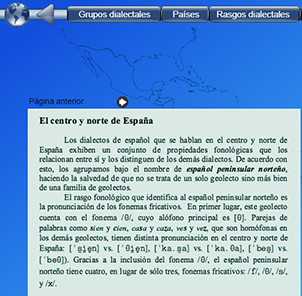1.2 What pronunciation to teach?
Spanish is spoken by nearly 600 million people worldwide. Of these, more than 450 million speak it as their mother tongue, distributed across four continents. This geographical spread has produced multiple variations in the language, not only in vocabulary and grammar, but also in pronunciation. These differences do not create major problems in terms of native speakers being able to easily understand each other. However, as Spanish is spoken so extensively, a complex task facing any teacher is deciding which variety or varieties to teach to their students and which linguistic features of the multiple varieties of this pluricentric language to present in the classroom. The variety with the greatest number of speakers? The one generally considered the most “respected”? The variety spoken by the teacher? All varieties?
The Common European Framework of Reference for Languages (CEFR by the Council of Europe) refers to dialectal variation as part of sociolinguistic competence, which includes awareness of dialect and accent. The Instituto Cervantes Curricular Plan (Plan Curricular del Instituto Cervantes) takes the cultivated norm of north-central Peninsular Spanish as its preferred dialect when it comes to selecting language resources. This choice is partly based on its association with other educated norms in Hispanic culture and on its prestige, although emphasis is placed on the pluricentric nature of Spanish. The treatment of dialectal varieties in the classroom generally depends on three main factors; where teaching staff come from, who is authoring teaching materials, and the students’ needs and expectations.
Since the majority of teaching materials in Britain come from Spain, standard written Spanish tends to be based on the varieties present in Spain (and, within these, mainly español septentrional). Nevertheless, there is great interest among scholars and course material developers in producing materials that include the global perspective of the language. Among practitioners, there is some interest in teaching a “general” Spanish, a variety that is not regionally marked in terms of grammar and pronunciation and which incorporates the most widely used vocabulary. Needless to say, teachers can change their approach to teaching different dialects depending on the problems and needs that arise in the course of their work. The choice will ultimately depend on students’ needs and interests, and teachers’ skills.
References
Ideas for exercises
A great tool to get learners acquainted with the phonetic features of the major Spanish dialects is the Dialectoteca del español developed by Prof. Carlos-Eduardo Piñeros at the University of Iowa: http://dialects.its.uiowa.edu/ main.html
Students at level B1 can familiarise themselves with the similarities and differences of the major dialectal blocks (Peninsular norteño, Terraltense and Terrabajense). You can find a brief description of the distinctive phonetic characteristics of the dialectal areas, as well as samples of the given accent.
For higher levels, you might show samples from various dialects – you can search Dialectoteca by country as well as by phonetic feature – and students can guess which area the given sample belongs to. You can then analyse the characteristic features of the samples together.

